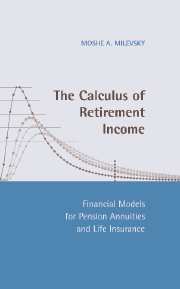Book contents
- Frontmatter
- Contents
- List of Figures and Tables
- I MODELS OF ACTUARIAL FINANCE
- 1 Introduction and Motivation
- 2 Modeling the Human Life Cycle
- 3 Models of Human Mortality
- 4 Valuation Models of Deterministic Interest
- 5 Models of Risky Financial Investments
- 6 Models of Pension Life Annuities
- 7 Models of Life Insurance
- 8 Models of DB vs. DC Pensions
- II WEALTH MANAGEMENT: APPLICATIONS AND IMPLICATIONS
- III ADVANCED TOPICS
- Bibliography
- Index
3 - Models of Human Mortality
from I - MODELS OF ACTUARIAL FINANCE
Published online by Cambridge University Press: 06 July 2010
- Frontmatter
- Contents
- List of Figures and Tables
- I MODELS OF ACTUARIAL FINANCE
- 1 Introduction and Motivation
- 2 Modeling the Human Life Cycle
- 3 Models of Human Mortality
- 4 Valuation Models of Deterministic Interest
- 5 Models of Risky Financial Investments
- 6 Models of Pension Life Annuities
- 7 Models of Life Insurance
- 8 Models of DB vs. DC Pensions
- II WEALTH MANAGEMENT: APPLICATIONS AND IMPLICATIONS
- III ADVANCED TOPICS
- Bibliography
- Index
Summary
Mortality Tables and Rates
It is time to get a bit more technical. In this chapter I will cover most of what you need to know about mortality rates and tables in order to appreciate the valuation and pricing of mortality-contingent claims. At various points I will be using basic calculus to express the underlying mathematics. But please don't be discouraged if the material appears somewhat esoteric or theoretical. My main objective is to arrive at a collection of formulas that can be used independently of whether you understand every step of how they were derived.
To begin with, the basis of all pension and insurance valuation is the mortality table. A mortality table—perhaps better referred to as a vector or collection of numbers—maps or translates an age group x into a probability of death, qx, during the next year. For example, q35 is the probability of dying before your 36th birthday, assuming you are alive on your 35th birthday. By definition, 0 ≤ qx ≤ 1 and qN = 1 for some large enough N ≈ 110. Table 3.1 displays a portion of one of the hundreds of different mortality tables. This one is called the RP2000 (where “RP” denotes retirement pension) healthy annuitant mortality table, which is available from the Society of Actuaries, 〈www.soa.org〉. This portion of the table displays conditional death rates from age x = 50 to age x = 105 only in increments of 5 years; the complete table is provided in Chapter 14 of this book.
- Type
- Chapter
- Information
- The Calculus of Retirement IncomeFinancial Models for Pension Annuities and Life Insurance, pp. 34 - 63Publisher: Cambridge University PressPrint publication year: 2006



